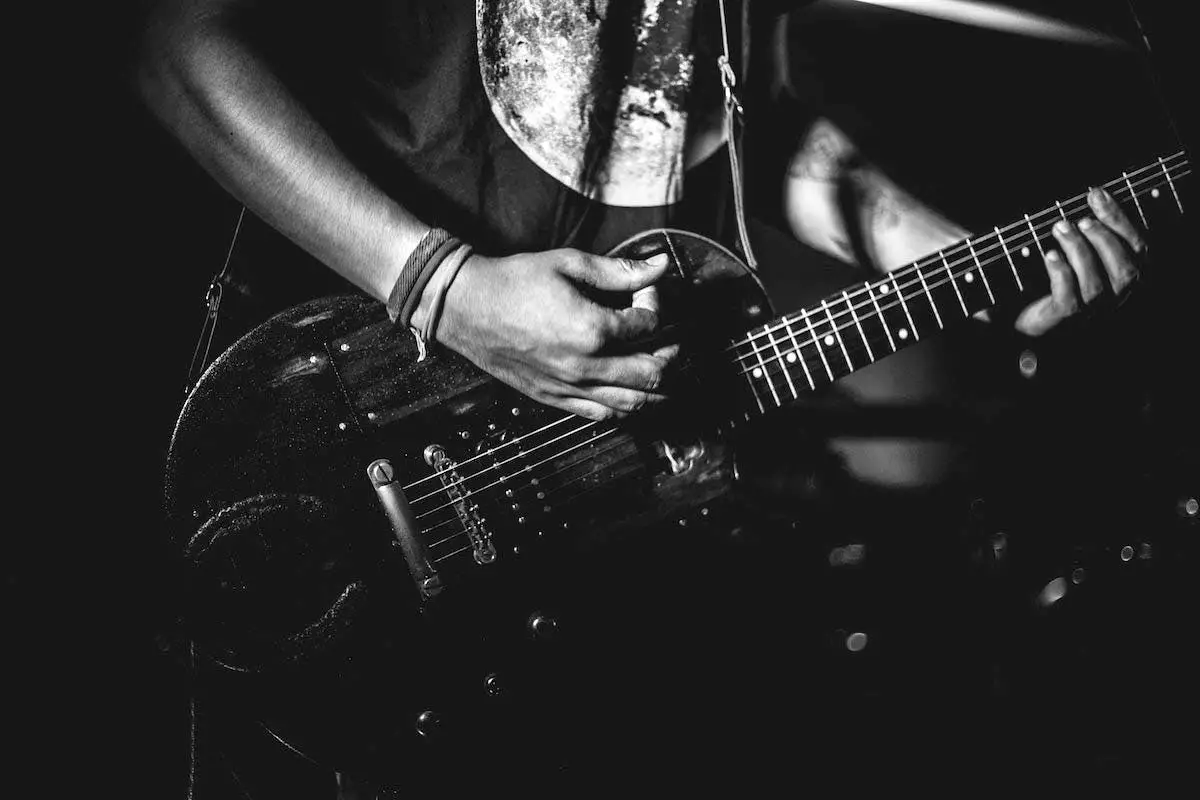As guitarists, we understand that the quest for the perfect sound begins with precise tuning. From the raw energy of rock to the thunderous heaviness of metal, the importance of tuning cannot be overstated. Today we explore tuning a guitar to Drop C.
In this article, we not only delve into the significance of proper guitar tuning, but also introduce you to the mesmerizing world of drop tunings. Popularized by many heavy metal bands bands like Slipknot, Bring Me the Horizon, and Killswitch Engage, Drop C tuning offers a captivating tonal landscape that has also found a home in various genres, including metalcore, post-hardcore music, and alternative rock.
Read on to learn the basics, benefits, & how to tune your electric guitar to Drop C.

Drop C Guitar Tuning Basics
Drop C tuning is an alternative tuning that deviates from the standard tuning (EADGBE) by lowering the pitch of each guitar string. In Drop C tuning, the low e string (thickest string) is dropped two whole steps to C, while the other guitar strings are dropped 1 whole step, although in an identical configuration as standard tuning. The resulting tuning is CGCFAD, with the low C providing a deeper and heavier sound.
The main difference between Drop C tuning and standard EADGBE tuning lies in the lowered sixth string. This alteration allows guitarists to achieve a heavier and more powerful tone, particularly suited for genres like metal, hard rock, and punk. By having the low C, guitarists can play power chords with a single finger barring the lowest three strings, which creates a massive sound with an added depth.
The lower tuning also facilitates palm-muted chugs and open-string riffs, enabling a chunky and aggressive playing style. This tuning offers versatility and allows guitarists to explore both heavy and melodic elements, opening up a wide range of creative possibilities and capturing the essence of hard-hitting music.

Why Play In Drop C Guitar Tuning
Drop C tuning offers several benefits for guitarists, particularly those playing heavy or aggressive styles of music. Here are some of the advantages of using Drop C tuning:
Heavy and Powerful Sound
Drop C tuning allows for lower, heavier notes, which can create a powerful and aggressive sound. The lower pitch enhances the weight and depth of the guitar’s tone, making it ideal for genres like metal, hard rock, and alternative rock.
Easy Power Chords
Drop C tuning simplifies playing power chords by enabling them to be played using one finger across the fretboard. This makes it easier to achieve a full and thick sound, facilitating the execution of heavy riffs and chord progressions.
Extended Range
By tuning the low E string down two whole steps to C, guitarists expand the instrument’s range. This provides more flexibility for creating low-end riffs and exploring deeper tonal possibilities.
Increased Tension
The lower tuning increases guitar string tension, resulting in a tighter feel and greater control over the instrument. This can enhance precision while playing fast or intricate passages.
Enhanced Sustain
Lower tunings often lead to longer sustain on the strings. Notes can ring out more prominently, adding richness and depth to your playing.
Compatibility with Standard Tuning
Drop C tuning can still work well with songs and other guitarists using standard tuning. The placement of power chords and common chord shapes remains consistent, making it easier to switch between tunings during performances or collaborations.
Versatility
While Drop C tuning is commonly associated with heavier genres, it can also be used effectively in other musical styles. It offers a unique tonal palette that can add variety and a different sonic flavor to your playing.
How To Drop Tune Your Guitar To C
When tuning your guitar to Drop C, you are lowering the guitar string tension which can affect playability your overall tone. To maintain optimal tension, we recommend you use heavier gauge guitar strings (Like the 11-54 gauge “Beefy Slinky”) to compensate for the loss of tension. This ensures a desirable feel, better response, and prevents issues like string buzz or flabbiness.
Steps To Follow
- Using the tuning video below, start with the 6th string (thickest string). Play the open 6th string and listen to the tone whether the string is sharp (tuned too high) or flat (tuned too low). The goal is to reach a harmony to where your guitar’s pitch & the video pitch are the same.
If your string sounds sharp, loosen the tension . If your string sounds more flat, then tighten up the tension until you hear the correct note. Gradually adjust the tension while plucking the open string repeatedly. Keep making small adjustments until you hear the two tones perfectly in tune.
- Repeat the process for the remaining strings, working from the 5th string (A) to the 4th (D), 3rd (G), 2nd (B), and finally the 1st string (thinnest, E).
- Double-check the tuning of each string to ensure accuracy. Once all strings are tuned to Drop C, give them a few extra plucks to settle the tension, as the act of tuning can cause minor fluctuations.
Guitar Tuner
Adjustments & Considerations for Drop C Tuning
String Gauge
Using heavier string caliber is recommended to maintain optimal tension in Drop C tuning. Thicker strings provide better playability and tone while minimizing string floppiness. We recommend starting with 11-54 or 11-56 and then adjusting to what feels more comfortable to you.
Truss Rod Adjustment
Lowering the pitch to Drop C can affect the guitar’s neck relief. If you notice the neck becoming too straight or developing a backbow, adjusting the truss rod can help restore the ideal amount of relief. Consult your local guitar tech if you’re unsure about making your own truss rod adjustments.
Intonation Adjustment
Drop C tuning can impact the intonation, causing the guitar to play out of tune as you move up the neck. Adjust the saddle positions to ensure that the open string and the fretted notes at various positions are in tune. Proper intonation ensures accurate pitch across the fretboard.
Action Height
Drop C tuning may require adjusting the action height to achieve optimal playability. Lower the action slightly if there’s excessive string height that’s hard to press down or raise the action if you’re getting a lot of string buzz. Try & strike a balance between low action and avoiding string buzz.
Nut Slot Consideration
Ensure that the guitar nut slots are wide enough to accommodate the thicker strings. If the strings bind or get caught in the nut slots, it can affect tuning stability and playability. Consider having the nut slots widened or adjusted by a professional if needed.
Setup and Maintenance
Drop C tuning can put additional stress on the guitar, so it’s essential to ensure your instrument is properly set up & maintained. Regularly check and adjust the truss rod, intonation, and action as needed. Keep the guitar properly humidified and perform routine maintenance to keep it in optimal condition.
Bands That Play In Drop C Tuning
Here’s a few bands that are known for playing guitar in Drop C tuning. Know of any we should add to the list? comment below!
Slipknot: The heavy metal band Slipknot frequently uses Drop C tuning in their songs. It contributes to their aggressive and intense sound.
Bring Me the Horizon: This British rock band incorporates Drop C tuning in many of their songs, blending elements of metalcore, alternative rock, and electronic music.
Five Finger Death Punch: Known for their heavy and melodic metal sound, Five Finger Death Punch often tunes their guitars to Drop C, which adds to the heaviness and power of their music.
Killswitch Engage: A metalcore band, Killswitch Engage utilizes Drop C tuning extensively, creating a blend of melodic and aggressive guitar riffs in their songs.
Lamb of God: This American metal band favors Drop C tuning to achieve their signature groove-oriented and intense sound. It adds depth and heaviness to their music.
Songs In Drop C Tuning
Slipknot – “Duality”
Bring Me the Horizon – “Shadow Moses”
Five Finger Death Punch – “The Bleeding”
Killswitch Engage – “My Last Serenade”
Lamb of God – “Redneck”
Other Alternate Tunings To Explore
How To Tune An 8 String Guitar

Frequently Asked Questions
What string set for drop c tuning?
We recommend 11-54 or 11-56 gauge of strings for Drop C such as the Earnie Ball Burly Slinky. You can then go slightly higher or lower depending on your own personal preference.
Can you tune a 7 string guitar to drop c
You can tune a 7-string guitar to Drop C by using the CGCFADG tuning, with the lowest string tuned to G. Follow the same steps as tuning a 6-string guitar to Drop C, but remember to include the additional 7th string.
Adjustments to the truss rod, intonation, and possibly the nut slots may be necessary to accommodate the thicker strings and ensure proper tension and playability. Seeking professional help is recommended, especially for complex setups like a 7-string guitar.
Do you need thicker strings for drop c?
Yes, thicker strings are recommended when choosing to drop tune your guitar. This is because drop tuning lowers your string tension which can cause lighter gauge strings to feel loose & sound flabby. We recommend trying out some 11 gauge strings as a starting point.
Can you play drop d songs in drop c?
Yes, you can play songs in Drop D tuning on a guitar tuned to Drop C. All the notes and chord shapes from Drop D will still be playable, but the pitch will be one whole step lower in Drop C.
You will have to adjust your fingerings accordingly, moving them down two frets to maintain the same relative pitch. Keep in mind that the song will sound lower in pitch compared to the original recording, and it’s a matter of personal preference whether to transpose or enjoy the heavier sound of Drop D songs on guitar in Drop C.
